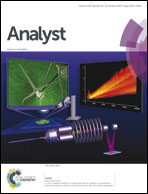Fluorescence turn-on detection of Sn2+ in live eukaryotic and prokaryotic cells†
Abstract
Sn2+ is usually added to toothpaste to prevent dental plaque and oral disease. However, studies of its physiological role and bacteriostatic mechanism are restricted by the lack of versatile Sn2+ detection methods applicable to live cells, including Streptococcus mutans. Here we report two Sn2+ fluorescent probes containing a rhodamine B derivative as a fluorophore, linked via the amide moiety to N,N-bis(2-hydroxyethyl)ethylenediamine (R1) and tert-butyl carbazate group (R2), respectively. These probes can selectively chelate Sn2+ and show marked fluorescence enhancement due to the ring open reaction of rhodamine induced by Sn2+ chelation. The probes have high sensitivity and selectivity for Sn2+ in the presence of various relevant metal ions. Particularly, both R1 and R2 can target lysosomes, and R2 can probe Sn concentrations in lysosomes with rather acidic microenvironment. Furthermore, these two probes have low toxicity and can be used as imaging probes for monitoring Sn2+ not only in live KB cells (eukaryotic) but also in Streptococcus mutans cells (prokaryotic), which is a useful tool to study the physiological function of Sn2+ in biological systems.


 Please wait while we load your content...
Please wait while we load your content...